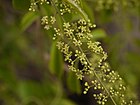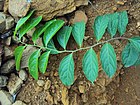Note: This is a project under development. The articles on this wiki are just being initiated and broadly incomplete. You can Help creating new pages.
Celastrus paniculatus - Jyotishmati
Jyotishmati is a deciduous, climbing shrub. The stems twine into the surrounding vegetation, helping to support themselves by means of hooked prickles. The plant is harvested from the wild for local use as a medicine and source of oil.
Uses
Parts Used
Chemical Composition
The seeds are reported to contain the alkaloids, celastrine and paniculatine, which are the active principles of the drug. [2]
Common names
| Language | Common name |
|---|---|
| Kannada | Bhavanga beeja, Gangunde kaayi, Gangunga hambu, Maala kanguni |
| Hindi | Malakanguni, Mlkauni |
| Malayalam | Ceruppunna, Palulavam, Paluzhavam |
| Tamil | Carasvati, Acuvalakkal, Malgangunicinnavaluluvai |
| Telugu | Baavanji, Gandumida, |
| Marathi | NA |
| Gujarathi | NA |
| Punjabi | NA |
| Kashmiri | NA |
| Sanskrit | Agnibhasa, Jyotishlata, Jyotishmati, Supingala, Swarna lata |
| English |
Properties
Reference: Dravya - Substance, Rasa - Taste, Guna - Qualities, Veerya - Potency, Vipaka - Post-digesion effect, Karma - Pharmacological activity, Prabhava - Therepeutics.
Dravya
Rasa
Tikta (Bitter), Katu (Pungent)
Guna
Teekshna (Strong), Snigdha (Oily)
Veerya
Ushna (Hot)
Vipaka
Katu (Pungent)
Karma
Vata, Kapha
Prabhava
Habit
Identification
Leaf
| Kind | Shape | Feature |
|---|---|---|
| Simple | Alternate | Broadly ovate, apex abruptly acuminate, base ronded or acute, crenulate; petiole 6 mm long |
Flower
| Type | Size | Color and composition | Stamen | More information |
|---|---|---|---|---|
| Bisexual | Terminal and axillary panicles | Yellowish white | 5 | Panicle to 15 x 8 cm, terminal, axillary, oblong; pedicel 6 mm long; flowers many, 6 mm across. Sepals 5, small, imbricate, ciliate. Petals 2.5 x 2 mm, white, ovate, obtuse. Stamens 5, erect, anthers sagitate at base. Ovary 3-celled, cell 2-ovuled, stigma 3, recurved. |
Fruit
| Type | Size | Mass | Appearance | Seeds | More information |
|---|---|---|---|---|---|
| A capsule | Capsule to 1 cm across, loculicidal, yellow | Seeds 3, aril reddish. | {{{5}}} | {{{6}}} |
Other features
List of Ayurvedic medicine in which the herb is used
Where to get the saplings
Mode of Propagation
How to plant/cultivate
Season to grow
Soil type
Propagation
Commonly seen growing in areas
Photo Gallery
References
External Links
- Ayurvedic Herbs known to be helpful to treat Memory loss
- Ayurvedic Herbs known to be helpful to treat Rheumatic arthritis
- Ayurvedic Herbs known to be helpful to treat Insomnia
- Ayurvedic Herbs known to be helpful to treat Opium poisoning
- Ayurvedic Herbs known to be helpful to treat Impotence
- Herbs with Seeds used in medicine
- Herbs with Leaves used in medicine
- Herbs with common name in Kannada
- Herbs with common name in Hindi
- Herbs with common name in Malayalam
- Herbs with common name in Tamil
- Herbs with common name in Telugu
- Herbs with common name in Sanskrit
- Habit - Climber
- Index of Plants which can be propagated by Seeds
- Index of Plants which can be propagated by Cuttings
- Herbs that are commonly seen in the region of Tropical area
- Herbs
- Climber
- Celastraceae





